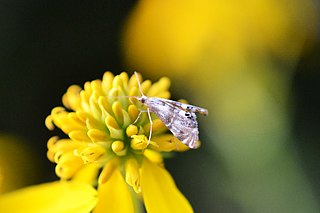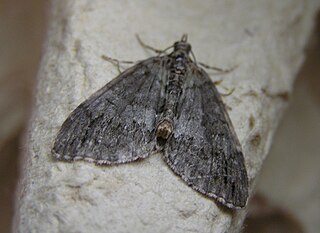Related Research Articles

Petrophila is a genus of moths of the family Crambidae. The genus was described by Lansdown Guilding in 1830.

Hemigrotella is a monotypic moth genus of the family Noctuidae. Its only species, Hemigrotella argenteostriata, is found in southern California. Both the genus and species were first described by William Barnes and James Halliday McDunnough in 1918.

Hydriomena is a genus of moths in the family Geometridae described by Jacob Hübner in 1825.
Drasteria hudsonica, the northern arches, is a moth of the family Erebidae. The species was first described by Augustus Radcliffe Grote and Coleman Townsend Robinson in 1865. It is found from Alaska and Yukon to California, east to New Mexico and Manitoba.
Acroncosa is a genus of snout moths in the subfamily Phycitinae. It was described by William Barnes and James Halliday McDunnough in 1917. The type species is Acroncosa albiflavella.
Acroncosa albiflavella is a species of moth of the family Pyralidae, of the order Lepidoptera. Acroncosa albiflavella was described by William Barnes and James Halliday McDunnough in 1917. It is found in western North America, including New Mexico and California.
Acroncosa similella is a species of snout moth in the genus Acroncosa. It was described by William Barnes and James Halliday McDunnough in 1917. It is found in the US state of California.
Crambidia impura is a moth of the family Erebidae. It was described by William Barnes and James Halliday McDunnough in 1913. There are two disjunct populations. It has been recorded from southern Rocky Mountain states, the Yukon and northern British Columbia and Alberta. The habitat consists of stabilized sand dunes dominated by open jack pine forests.

Givira lucretia is a moth in the family Cossidae first described by William Barnes and James Halliday McDunnough in 1913. It is found in North America, where it has been recorded from Arizona, Texas and Wyoming.
Hamilcara is a monotypic moth genus in the family Cossidae. Its only species, Hamilcara atra, is found in North America, where it has been recorded from Arizona. The genus and species were first described by William Barnes and James Halliday McDunnough in 1910.
Crambus awemellus is a moth in the family Crambidae. It was described by James Halliday McDunnough in 1921. It is found in North America, where it has been recorded from Alberta, Manitoba, Ontario and Quebec. The habitat consists of marl fens.
Loxocrambus awemensis is a moth in the family Crambidae. It was described by James Halliday McDunnough in 1929. It is found in North America, where it has been recorded from Manitoba, Alberta, Michigan and Ontario. The habitat consists of sand dunes.
Pediasia ericella is a moth in the family Crambidae. It was described by William Barnes and James Halliday McDunnough in 1918. It is found in North America, where it has been recorded from California and Alberta. The habitat consists of prairies and aspen parklands.
Evergestis subterminalis is a moth in the family Crambidae. It was described by William Barnes and James Halliday McDunnough in 1914. It is found in western North America, where it has been recorded from west central Alberta south to Colorado, Utah and California. The habitat consists of montane meadows.
Evergestis vinctalis is a moth in the family Crambidae. It was described by William Barnes and James Halliday McDunnough in 1914. It is found in North America, where it has been recorded from Alberta, Arizona, British Columbia, California, Colorado, Kansas, Montana, Nevada, New Mexico, Texas and Wyoming.
Orenaia alticolalis is a moth in the family Crambidae. It was described by William Barnes and James Halliday McDunnough in 1914. It is found in North America, where it has been recorded from Alberta and Colorado.
Loxostege anartalis is a moth in the family Crambidae. It was described by Augustus Radcliffe Grote in 1878. It is found in North America, where it has been recorded from coast to coast in Canada. In the west, the range extends south to California.
Pyrausta tuolumnalis is a moth in the family Crambidae. It was described by William Barnes and James Halliday McDunnough in 1918. It is found in North America, where it has been recorded from the western Northwest Territories and Yukon, south through British Columbia and Alberta to the mountains of California and New Mexico. The habitat consists of forested areas in the mountains.

Eudonia spaldingalis is a moth in the family Crambidae. It was described by William Barnes and James Halliday McDunnough in 1912. It is found in North America, where it has been recorded from Alberta, Arizona, British Columbia, California, Colorado, Montana, Nevada, New Mexico, Utah and Wyoming.
Choristostigma disputalis is a moth in the family Crambidae. It was described by William Barnes and James Halliday McDunnough in 1917. It is found in North America, where it has been recorded from Alberta, Arizona, British Columbia, California and Oregon.
References
- ↑ Nuss, M.; et al. (2003–2014). "GlobIZ search". Global Information System on Pyraloidea. Retrieved July 15, 2014.
- ↑ "800753.00 – 4773 – Petrophila kearfottalis – Petrophila Species Group – (Barnes & McDunnough, 1917)". North American Moth Photographers Group. Mississippi State University. Retrieved June 15, 2019.
- ↑ Bird, C. D. (2009). "Species Details: Petrophila kearfottalis". University of Alberta Museums. E.H. Strickland Entomological Museum. Retrieved December 29, 2020.